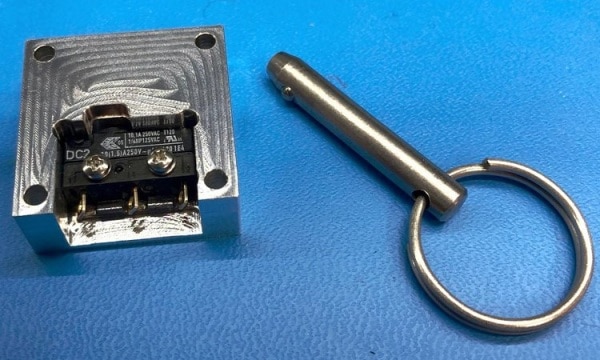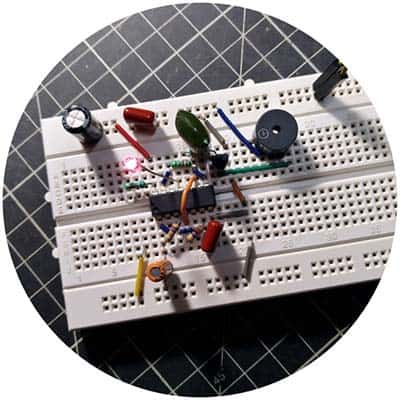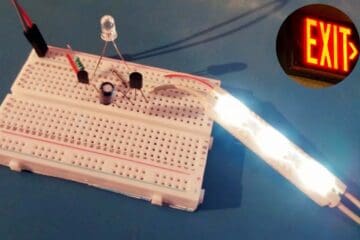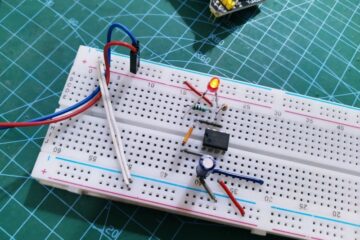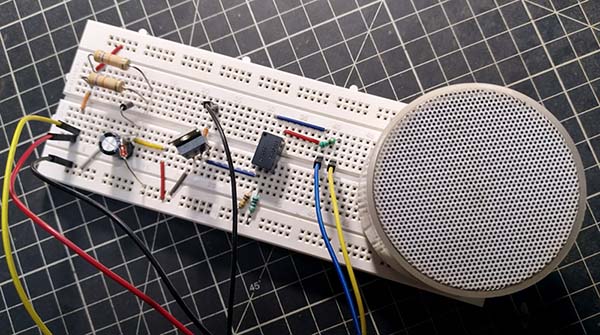
I had to develop a quick design to cook up a simple anti-rape alarm/personal alarm, but using only a handful of inexpensive and readily available electronic components. I came up with this solution. I am sure someone else has done something similar (or better) before, but it was fun figuring it out for myself. I think this is the right time to share my adaptable design idea with you.
Well, let me start by showing its schematic which is quite simple and straightforward.
It uses the CD4093B (IC1) as the core part. The CD4093B is a Quad 2-Input NAND Schmitt Trigger. That means the 14-pin IC consists of four Schmitt-trigger circuits. Each circuit functions as a 2-input NAND gate with Schmitt trigger action on both inputs. All outputs have equal source and sink currents and conform to standard B-series output drive.
The design introduced here can be tailored to work with a wide range of mechanical, electrical, or electronic switches/sensors. At this point a standard pull-pin switch (see below) is suggested, but you can choose anything that seems suitable to your specific application.
In a common pull-pin switch, a spring-loaded quick-release pin stays firmly in the switch body until pulled. A pull-pin switch is usually made from metal or plastic, and pulling the pin toggles a two-way microswitch that’s housed inside. So, when using the pull-pin switch it is possible for the user to quickly pull the pin thereby activating (or deactivating) the connected electronics at once.
This is the link to download a general datasheet/leaflet https://www.alliedelec.com/m/d/6a354c26a4793129a058b5ccc9ef521c.pdf
Okay, let us go back to the schematic to analyze its background electronics!
Since the idea is to activate an ear-splitting warning tone when the pull-pin switch is triggered by the user, a low-frequency audio signal generator (simply a wailing siren) is wired using the first two gates (IC1A-IC1B) of the CD4093B (IC1). Note that only the common (C) normal closed (NC) switch points of the pull-pin switch (S1) are used here, so the alarm will turn on when a user pulls out the safety pin.
Actually, the pull-pin switch, when armed, turns on the power supply to the alarm circuit, and the alarm circuit then sends a warning sound through one compact piezo-speaker (PZS) until it’s turned off again. I choose a small “external driven magnetic buzzer” because it’s commonly used in quartz alarm clocks and desktop computer motherboards, and are available everywhere (see a sample image below). But you could of course use other acoustic sounders that fit your needs. Remember, this is not a typical active piezo-buzzer!
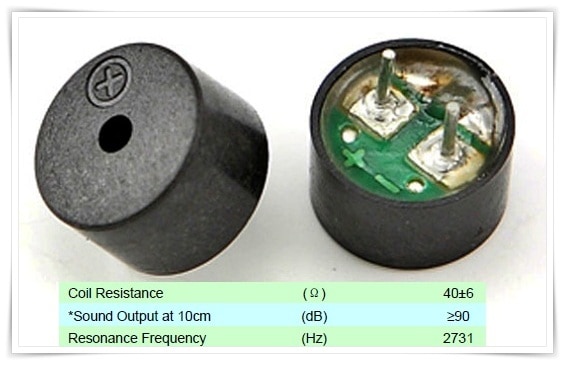
To get the first Schmitt trigger (IC1A) to start oscillating we only need to add a resistor (R1) and a capacitor (C1). One of the other things that makes using the CD4093B as an oscillator so fun and simple is how easy it is to change the pitch – all you need to do is add a potentiometer wired in series with the resistor R1. Since IC1 has four independent gates, it’s always nice to have even more options. Therefore, a second oscillator is built around the next gate (IC1B), and the first oscillator (IC1A) is used to ‘gate’ the second one. You can see the output of IC1B (Pin 4) in the random oscilloscope trace included below.

As you can now see, output of the second oscillator is routed to the piezo-speaker driver transistor 2N4401 (T1) through the third gate (IC1C) of CD4093B which simply functions as an ‘inverting buffer’. Finally, the fourth gate (IC1D) is exploited to run a visual indicator (LED1).
The 2N4401 transistor might seem a strange choice, but I picked it just because it’s ready to hand during my breadboard experiments. If you don’t have one in stock, then I recommend you to try out the s8050 or S 9013 transistor.
This is my quick breadboard assembly of the anti-rape/personal alarm. The crude setup is powered by a 6F22 9V battery that is not caught on my smartphone camera. I do not have enough space in my dirty workbench for widescreen photography, sorry about that!
Do you want buy one online?
The National Sexual Violence Resource Centre (U.S) has estimated that one in five women will be raped at some time in their lives. This is a terrifying statistic that should have women anxious and keen to protect themselves (https://www.psychologytoday.com/intl).
While wearable alarm devices and smartphone apps aren’t the answer, they can help keep girls and women safe in many situations. So, such a self-defence device is a must these days especially for active women who want to enjoy the freedom of exercise in the early morning hours, or in the late evenings after work without worry.

At this moment, note that there are two basic types of anti-rape/personal alarms: non-monitored and monitored (needless to say, ours is a very basic alarm project). The key difference is explained in this post https://www.personalalarms.net.au/2013/11/17/monitored-personal-alarm/

There are many Chinese anti-rape/personal alarms available in the online market. Most of them are very nice to look at, but most are often very expensive and perform poorly. Also, most products are based on cheap Chinese chip-on-board (COBs) parts, so it is very difficult to repair them (in my experience that’s so).
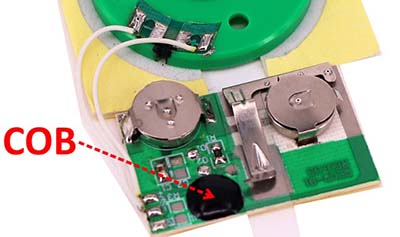
On that basis, the best decision is to build it yourself, because it is more flexible and opens the door to more expansion. For example, you can easily turn it into an internet-connected device. Below is an enclosure model for your reference.

Well, it turned out to be perfectly feasible, but I’m aiming at something with more features than my basic design. So, stay tuned if you want to see the amended project. Surely there’s a delay, I hear your claim!


